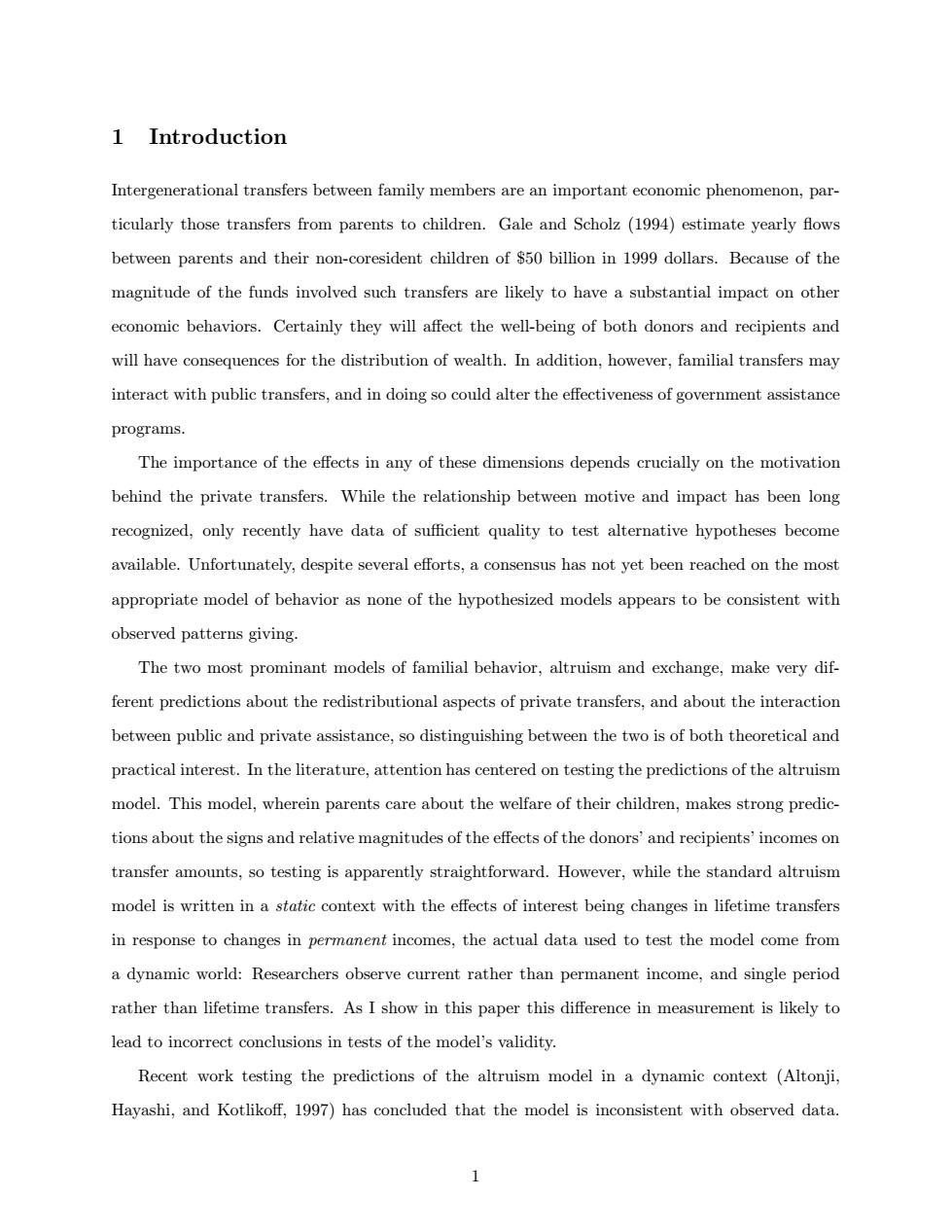正在加载图片...

1 Introduction Intergenerational transfers between family members are an important economic phenomenon,par- ticularly those transfers from parents to children.Gale and Scholz (1994)estimate yearly flows between parents and their non-coresident children of $50 billion in 1999 dollars.Because of the magnitude of the funds involved such transfers are likely to have a substantial impact on other economic behaviors.Certainly they will affect the well-being of both donors and recipients and will have consequences for the distribution of wealth.In addition,however,familial transfers may interact with public transfers,and in doing so could alter the effectiveness of government assistance programs. The importance of the effects in any of these dimensions depends crucially on the motivation behind the private transfers.While the relationship between motive and impact has been long recognized,only recently have data of sufficient quality to test alternative hypotheses become available.Unfortunately,despite several efforts,a consensus has not yet been reached on the most appropriate model of behavior as none of the hypothesized models appears to be consistent with observed patterns giving. The two most prominant models of familial behavior,altruism and exchange,make very dif- ferent predictions about the redistributional aspects of private transfers,and about the interaction between public and private assistance,so distinguishing between the two is of both theoretical and practical interest.In the literature,attention has centered on testing the predictions of the altruism model.This model,wherein parents care about the welfare of their children,makes strong predic- tions about the signs and relative magnitudes of the effects of the donors'and recipients'incomes on transfer amounts,so testing is apparently straightforward.However,while the standard altruism model is written in a static context with the effects of interest being changes in lifetime transfers in response to changes in permanent incomes,the actual data used to test the model come from a dynamic world:Researchers observe current rather than permanent income,and single period rather than lifetime transfers.As I show in this paper this difference in measurement is likely to lead to incorrect conclusions in tests of the model's validity. Recent work testing the predictions of the altruism model in a dynamic context (Altonji, Hayashi,and Kotlikoff,1997)has concluded that the model is inconsistent with observed data.1 Introduction Intergenerational transfers between family members are an important economic phenomenon, particularly those transfers from parents to children. Gale and Scholz (1994) estimate yearly flows between parents and their non-coresident children of $50 billion in 1999 dollars. Because of the magnitude of the funds involved such transfers are likely to have a substantial impact on other economic behaviors. Certainly they will affect the well-being of both donors and recipients and will have consequences for the distribution of wealth. In addition, however, familial transfers may interact with public transfers, and in doing so could alter the effectiveness of government assistance programs. The importance of the effects in any of these dimensions depends crucially on the motivation behind the private transfers. While the relationship between motive and impact has been long recognized, only recently have data of sufficient quality to test alternative hypotheses become available. Unfortunately, despite several efforts, a consensus has not yet been reached on the most appropriate model of behavior as none of the hypothesized models appears to be consistent with observed patterns giving. The two most prominant models of familial behavior, altruism and exchange, make very different predictions about the redistributional aspects of private transfers, and about the interaction between public and private assistance, so distinguishing between the two is of both theoretical and practical interest. In the literature, attention has centered on testing the predictions of the altruism model. This model, wherein parents care about the welfare of their children, makes strong predictions about the signs and relative magnitudes of the effects of the donors’ and recipients’ incomes on transfer amounts, so testing is apparently straightforward. However, while the standard altruism model is written in a static context with the effects of interest being changes in lifetime transfers in response to changes in permanent incomes, the actual data used to test the model come from a dynamic world: Researchers observe current rather than permanent income, and single period rather than lifetime transfers. As I show in this paper this difference in measurement is likely to lead to incorrect conclusions in tests of the model’s validity. Recent work testing the predictions of the altruism model in a dynamic context (Altonji, Hayashi, and Kotlikoff, 1997) has concluded that the model is inconsistent with observed data. 1